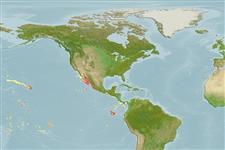Elasmobranchii (haaien en roggen) (sharks and rays) >
Carcharhiniformes (Ground sharks) >
Pentanchidae (Deepwater catsharks)
Etymology: Cephalurus: cephalus, from kephale (Gr.), head, referring to its expanded, flattened and rounded head; ailouros (Gr.), cat, probably an allusion to the vernacular “catshark,” so named for its cat-like eyes. (See ETYFish); cephalus: From kephale (Gr.), head, allusion not explained, probably referring to its expanded, flattened and rounded head, “much wider” and with larger pores compared with the similar Parmaturus xaniurus, its presumed congener at the time. (See ETYFish).
More on author: Gilbert.
Environment: milieu / climate zone / depth range / distribution range
Ecologie
marien bathydemersaal; diepte 155 - 927 m (Ref. 244). Deep-water; 32°N - 15°S
Eastern Central Pacific: southern Baja California, Mexico and Gulf of California. Cephalurus specimens from Panama, Peru and Chile differ from Cephalurus cephalus and may represent one or more new species.
Lengte bij maturiteit / Grootte / Gewicht / Leeftijd
Maturity: Lm ?, range 19 - ? cm
Max length : 28.0 cm TL mannelijk / geslacht onbekend; (Ref. 244); common length : 24.0 cm TL mannelijk / geslacht onbekend; (Ref. 244)
Found on the upper continental slope and outermost shelf. The expanded branchial region of this shark suggests that they are adapted to bottom areas with low dissolved oxygen levels. With little information available, reproductive mode could either be ovoviviparous (Ref. 244, 53776) or oviparous, paired eggs are laid (Ref. 50449).
Oviparous, paired eggs are laid. Embryos feed solely on yolk (Ref. 50449). Other sources describe ovoviviparity as an alternative reproductive mode (Ref. 244, 53776).
Compagno, L.J.V., 1984. FAO Species Catalogue. Vol. 4. Sharks of the world. An annotated and illustrated catalogue of shark species known to date. Part 2 - Carcharhiniformes. FAO Fish. Synop. 125(4/2):251-655. Rome: FAO. (Ref. 244)
Status op de Rode Lijst van het IUCN (Ref. 130435)
Gevaar voor de mens
Harmless
Gebruik door de mens
Visserij: van geen belang
Meer informatie
ReferentiesAquacultuurAquacultuurprofielKweeklijnenGeneticaElectrophoresesErfelijkheidZiektesVerwerkingNutrientsMassaconversie
Tools
Speciale rapporten
Download XML
Internetbronnen
Estimates based on models
Preferred temperature (Ref.
123201): 7.9 - 14.8, mean 9.5 °C (based on 31 cells).
Fylogenetische diversiteitsindex (Ref.
82804): PD
50 = 1.0000 [Uniqueness, from 0.5 = low to 2.0 = high].
Bayesian length-weight: a=0.00398 (0.00236 - 0.00672), b=3.06 (2.91 - 3.21), in cm total length, based on LWR estimates for this species & (Sub)family-body (Ref.
93245).
Trofisch niveau (Ref.
69278): 3.7 ±0.4 se; based on diet studies.
Weerstandsvermogen (Ref.
120179): Zeer laag, minimale populatieverdubbelingstijd meer dan 14 jaar (Fec=2).
Fishing Vulnerability (Ref.
59153): Low vulnerability (18 of 100).
